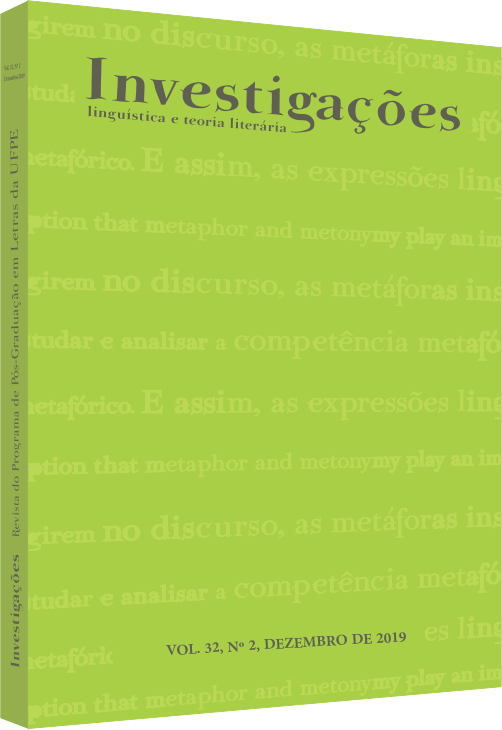Morfologia flexional dos verbos no português brasileiro e no crioulo haitiano
DOI:
https://doi.org/10.51359/2175-294x.2019.241664Keywords:
inflectional morphology, brazilian portuguese, haitian creole.Abstract
This article presents a comparative bibliographic analysis of the inflexional morphology of Haitian Creole (HC) and Brazilian Portuguese (BP). We surveyed aspects of the verbal morphology of both languages, analyzed and discussed the written data collected from native speakers of CH in order to illustrate how they use verbs in BP. Confirming the hypothesis that, given the morphological difference between the two languages, Haitian speakers tend to face difficulties when using Portuguese verbal tenses, inflexion and agreement, the analysis we carried out showed inadequacies in their use of inflexion of tense, number, and person when writing.References
BENTOLILA, A. Marques aspecto-temporelles en créole haïtien: de l’analyse synchronique à la formulation d’hypothèses diachroniques. La Linguistique. n. 23, p. 103-122. 1987.
BOUDREAUX, I. Is French a Creole Language? (Dissertation) Baylor University, Waco: Texas, 2014.
DEGRAFF, M. Kreyòl Ayisien, or Haitian Creole (‘Creole French’). In: HOLM, J.; PATRICK, P. L. (Eds.). Comparative Creole Syntax: Parallel Outlines of 18 Creole Grammars. London: Battlebridge Publications, p. 101 – 126, 2007.
DEGRAFF, M. Morphology and Word Order in "Creolization" and Beyond. In: CINQUE, G.; KAYNE, R. (Eds.) The Oxford Handbook of Comparative Syntax. New York: Oxford University Press. 2008.
RODRIGUES, L. C. B. Francês, crioulo e vodu: a relação entre língua e religião no Haiti. Tese (Doutorado) Universidade Federal do Rio de Janeiro, Rio de Janeiro, 2008.
SPEARS, A. Introduction: The Haitian Creole language. In.: SPERAS, A.; JOSEPH, C. The Haitian Creole language: history, structure, use, and education.. Lanham, MD: Lexington Books, 2010.
LEFEBVRE, C. Functional Categories in Tree Atlantic Creoles: Saramaccan, Haitian and Papiamentu. Université du Québec à Montréal. 2015.
LEFEBVRE, C. Creole Genesis and the Acquisition of Grammar: the case of Haitian Creole. Cambridge university press. 2006.
LIMA, R. Gramática Normativa da Língua Portuguesa. Rio de Janeiro: José Olympio, 2003.
MAIA, J. D. Gramática: teoria e exercícios. São Paulo: Ática. 1995
ILARI, R. BASSO, R. M. Verbo. In.: ILARI, R. MOURA NEVES, M. H. (Org.) Gramática do português culto falado no Brasil. Volume 2.Campinas: UNICAMP, 2008.
CÂMARA JR., J. M. Estrutura da língua portuguesa. Petrópolis: Vozes, 2017.
PARSONS, T. Thematic relations and arguments. Linguistic Inquiry, n. 26, 1995.
VALDMAN, A. Pidgin and creole linguistics. London: Indiana University Press, 1977.
VALDMAN, A. Diglossia and language conflict in Haiti. International Journal of the Sociology of Language. n. 71, p. 67–80. 1988.
Downloads
Published
How to Cite
Issue
Section
License
Copyright (c) 2019 Lovania Roehrig Teixeira, Susiele Machry da Silva

This work is licensed under a Creative Commons Attribution 4.0 International License.
Authors who publish with Revista Investigações agree to the following terms:
Authors retain copyright and grant the journal right of first publication with the work simultaneously licensed under the Creative Commons Attribution 4.0 International (CC BY 4.0) license that allows others to share the work with an acknowledgement of the work's authorship and initial publication in this journal.
Authors are able to enter into separate, additional contractual arrangements for the non-exclusive distribution of the journal's published version of the work (e.g., post it to an institutional repository or publish it in a book), with an acknowledgement of its initial publication in this journal.
You are free to:
Share — copy and redistribute the material in any medium or format for any purpose, even commercially.
Adapt — remix, transform, and build upon the material for any purpose, even commercially.
The licensor cannot revoke these freedoms as long as you follow the license terms.
Under the following terms:
Attribution — You must give appropriate credit , provide a link to the license, and indicate if changes were made . You may do so in any reasonable manner, but not in any way that suggests the licensor endorses you or your use.
No additional restrictions — You may not apply legal terms or technological measures that legally restrict others from doing anything the license permits.

